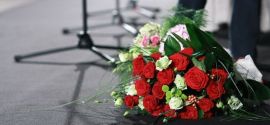Stanisław Baj
EXHIBITION OF STANISŁAW BAJ WORKS
At the Architect’s House Gallery, as part of the festival, an exhibition of paintings by Stanisław Baj will be held.
Stanisław Baj
He began to study art in the years 1972 – 1978 at the Faculty of Painting of the Warsaw Academy of Fine Arts. He received his diploma with distinction in 1978 under tutelage of Professor Ludwik Maciąg. This year, he celebrates 30th anniversary of his artistic work.
In 1990 he has taken over the Drawing Workshop at the Chair of Painting and Drawing of Professor Gostomski. In 2002, he received the professorship at his home academy. He holds the position of the Vice-President. He is considered as one of the most outstanding representatives of Polish contemporary art.
He was born in Podlasie region, in Dołhobrody at the Bug river, in the Hanna commune, in the north-eastern part of the poviat of Włodawa. It played a significant role in his artistic work. Both the outstanding beauty of the landscape of his homeland and its community have become the source of unending artistic inspiration. Unusual attention he gives to this place and the people who are so close to him, as well as the authenticity and sincerity of his artistic statement, arising out of the need of self-definition and the sense of mission in the work of preserving the world that is passing away, gives birth to unusual creativity, with exceptional emotional charge and excellent form.
We can distinguish two kinds of works in his creative activity: the portrait and the moody and symbolic landscapes. The heroes of a rich gallery of portraits are parents, cousins, neighbours. An inquisitive characterisation of the model is combined by the artist with the mastery of painting technique, also present in moody and symbolic landscapes, the major topic of them being the river Bug.
The author thus speaks about his work:
“…I paint my life, my agonies, desires and yearnings, my Mom, neighbours, the manure, the grey of the field, the night, cock’s crowing in the morning. I paint peasantry in its everyday life, in grey in its various shades. It gives the tone to everything, it gives rise to all the peasant’s commonness, but its strength also. Today, we know less and less on what the peasant’s world is like, it is more and more difficult to look into his face, grab the sleeve of his jacket to ask him, what he is like. When peasants go away, as they do, as the countryside goes away, the countryside that coped on its own with life, love, culture, faith… It has invented itself and for itself – and for us – its greatest chef d’oeuvre – the Christ as the Man of Sorrows. It cured itself and scared itself inventing legions of ghosts, sceptres, devils. If such countryside goes away, a few portraits of it will be at least left behind. As on the stone, let footprints be left with us that here at the end of the world lived people who loved, suffered, and died. Close to the Polish soul, very very close to the land”.
“My painting is very much like as if I wrote… a testament, on behalf of all those peasants, who were and passed away, in the name of the Father and Mother and You all, where the peasant’s world ends. I want to paint such a peasant’s world, so as memory stays of this world lived through and passing away, which I hold as my best friend…”.









